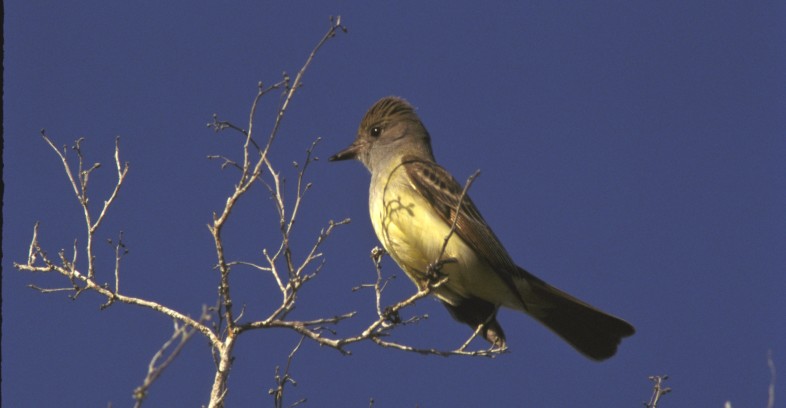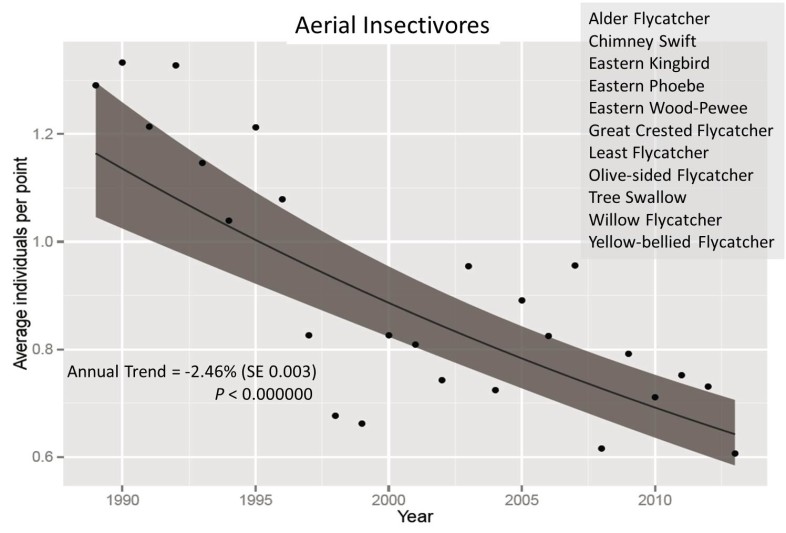
Great Crested Flycatcher, one of many aerial insectivores whose populations have declined. Photo by Steve Faccio.
Aerial insectivores have seen better times. For the last decade or so, ornithologists have noted steady declines in this diverse group of birds that feed almost exclusively on flying insects. Now, an analysis of 25 years of data from the Vermont Forest Bird Monitoring Program (FBMP) confirms this alarming trend at 31 Vermont study sites between 1989 and 2013.
In our region, 19 species are included in the aerial insectivore guild—mostly flycatchers, swallows, and nightjars (whip-poor-will and common nighthawk)—but since many are not found in forested habitats, only 11 species were detected on FBMP surveys. As a group, these 11 species showed a significant decline of 2.5% per year on our study sites (see Fig. 1), which equates to a 45% drop in their relative abundance over 25 years!

Figure 1. Population trend for the Aerial Insectivore guild, from Vermont Forest Bird Monitoring Program data, 1989-2013. The 11 species listed at top right are included in the guild.
Individually, only three aerial insectivores (Least Flycatcher, Eastern Wood-Pewee, and Great Crested Flycatcher) were detected in sufficient numbers to estimate their population trends with any confidence. Of these, both Eastern Wood-Pewee and Great Crested Flycatcher also showed significant declines (Fig. 2), with Great Crested Flycatchers dropping by 67% over 25 years and Pewees by 35%.

Figure 2. Population trends for Eastern Wood-Pewee and Great Crested Flycatcher, from Vermont Forest Bird Monitoring Program data, 1989-2013.
Although the reasons for these steep and alarming declines are unclear, it seems likely that several factors may be involved, including reduced abundance of flying insects (possibly due to polarized light pollution, pesticide use, and/or climate change), habitat loss, effects of West Nile virus, and changes in land-use practices. We also have to consider that the majority of these species are long-distance Neotropical migrants, over-wintering in Central and South America, where they may also face these threats in addition to others.
It’s interesting to note that in our FBMP data, all three graphs show very low counts in the late-1990s, which correspond to the arrival of West Nile virus. Both Eastern Wood-Pewee and Great Crested Flycatcher initially rebounded from those lows, but never fully recovered. It’s possible that this mosquito-borne virus is having persistent impacts to some birds, or perhaps birds in certain habitats are at a higher risk of West Nile infection.
Watch for our full report due out this spring—The Status of Vermont Forest Birds—which will detail results from the 25-year FBMP analysis, including population trends for 34 species and 13 ecological guilds!
Comments (1)
Pingbacks (1)
-
[…] Source: Vermont Forest Bird Monitoring Program Reveals Decline in Aerial Insectivores […]

Dramatically fewer swallows swooping over my pond in Plainfield, VT in the past few years. I hadn’t realized it was part of a larger decline in aerial insectivores until reading this blog.